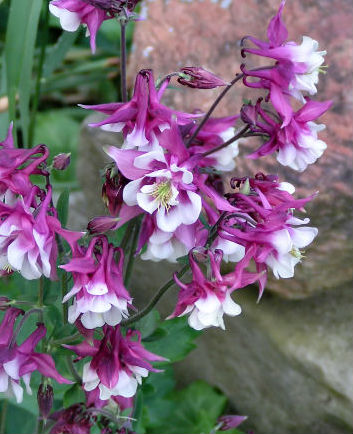 Shady Players
Shady Players
This blog is for all of you who are frustrated by your dark side. I’m talking about those dimly lit areas on your property that have succeeded in making you think they are untouchable. Before you grab a chainsaw and attack those lovely canopy trees, allow me to shed light on the situation. The truth is you have a gold mine in disguise; a treasure waiting to be uncovered.
Unfortunately it is a myth that sunny beds are prettier and easier than their shadier cousins. How did this fairy tale get started? I believe it’s because most people are more familiar with sun-loving plants and therefore conclude shade gardening offers few plant choices; translating to boring. But just because you haven’t been introduced to the magical and exquisite world of shade plants, doesn’t mean they don’t exist. In reality, there are many super perennials for shade that have unparalleled beauty and provide color spring, summer and fall. And I am not referring to just Hosta. I’m talking Foamflowers, Bishop’s Hat, Siberian Bugloss, Bugbane, Toad Lily, Masterwort, Ligularia, Hepatica and many other exotic beauties.
I much prefer shade gardening. Shade beds have a special mystique. They’re more intriguing and provocative than sun gardens plus they require much less maintenance. That caught your attention! There are four reasons why shade gardens provide more time in the lounge chair. Typically they demand less water, have fewer weeds and require less deadheading, a task I detest. Many shade perennials will not rebloom after deadheading. You can whack them off or leave the dried flowers for interest. The fourth factor contributing to less work in shade beds has to do with sunlight. Because there is less light, plants tend to grow more slowly which means less frequent dividing. Yes, dividing is good in that you get more plants and it stimulates new roots and better flowering, but it also takes your time and energy – not good.
So let’s start down this shady path together and rejoice in the journey. I bet after checking out some of the perennials below, you may want to add a shade tree to your yard. And another lounge chair. For more on shade gardening and great plants, purchase the book, Top Ten Lists for Beautiful Shade Gardens – Seeing Your Way Out of the Dark. We carry it at Faddegon’s.
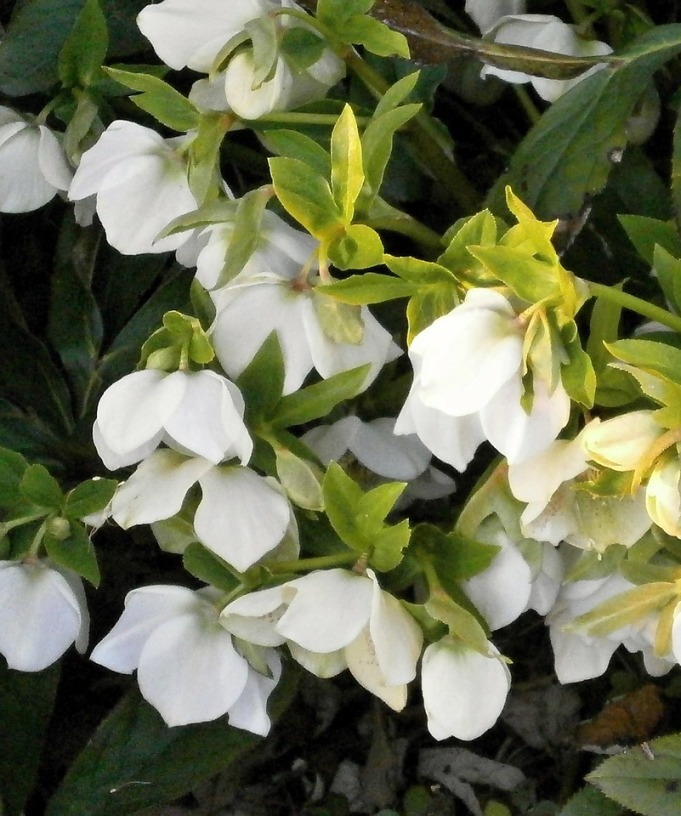 Lenten Rose (Helleborus) 12” – 24” tall. This 2005 Perennial Plant of the Year has nodding flowers in white, yellow, pink, red, burgundy as well as multicolor. Deep green leathery leaves are semi-evergreen in zones 5 and colder, a questionable benefit when they are buried under a foot of snow. Plants are ignored by deer, rabbits and other munchers. Lenten Rose is drought tolerant once established. Zones 4 – 9
Lenten Rose (Helleborus) 12” – 24” tall. This 2005 Perennial Plant of the Year has nodding flowers in white, yellow, pink, red, burgundy as well as multicolor. Deep green leathery leaves are semi-evergreen in zones 5 and colder, a questionable benefit when they are buried under a foot of snow. Plants are ignored by deer, rabbits and other munchers. Lenten Rose is drought tolerant once established. Zones 4 – 9
 Siberian Bugloss (Brunnera) 10” – 15” tall. Bright blue, forget-me-not like flowers billow above mounded, heart-shaped leaves. Leaves can be solid green or have silver, creamy yellow or white markings. I prefer the silvery variegated cultivars for their ability to reflect light in shadier spots. Plus the green leaved plant, macrophylla, seeds a bit too enthusiastically for me. ‘Jack Frost’ has silvery leaves with green veins; ‘Looking Glass’ has solid silver leaves; and ‘Variegata’ and ‘Hadspen Cream’ have green leaves with bold white margins. I ‘deadleaf’ Siberian Bugloss periodically in summer to remove foliage with brown edges. This also stimulates new leaves to unfurl. Zones 3 – 8+
Siberian Bugloss (Brunnera) 10” – 15” tall. Bright blue, forget-me-not like flowers billow above mounded, heart-shaped leaves. Leaves can be solid green or have silver, creamy yellow or white markings. I prefer the silvery variegated cultivars for their ability to reflect light in shadier spots. Plus the green leaved plant, macrophylla, seeds a bit too enthusiastically for me. ‘Jack Frost’ has silvery leaves with green veins; ‘Looking Glass’ has solid silver leaves; and ‘Variegata’ and ‘Hadspen Cream’ have green leaves with bold white margins. I ‘deadleaf’ Siberian Bugloss periodically in summer to remove foliage with brown edges. This also stimulates new leaves to unfurl. Zones 3 – 8+
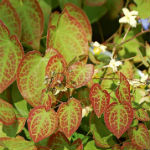 Barrenwort, Bishop’s Hat, Fairy Wings (Epimedium) 4” – 20” tall. This is my favorite groundcover for dry shade. It sneers at thirsty maple tree roots. Although it is frequently labeled a groundcover, I find it moves at a polite pace. Flowers can be white, pink, sulfur yellow, orange or bicolor. All flowers dangle from wiry stems that rise above elongated, heart-shaped foliage. Barrenwort’s leaves take on a pleasing burgundy cast in spring and sometimes again in fall. It partners beautifully with Hellebores. Zones 4 – 8
Barrenwort, Bishop’s Hat, Fairy Wings (Epimedium) 4” – 20” tall. This is my favorite groundcover for dry shade. It sneers at thirsty maple tree roots. Although it is frequently labeled a groundcover, I find it moves at a polite pace. Flowers can be white, pink, sulfur yellow, orange or bicolor. All flowers dangle from wiry stems that rise above elongated, heart-shaped foliage. Barrenwort’s leaves take on a pleasing burgundy cast in spring and sometimes again in fall. It partners beautifully with Hellebores. Zones 4 – 8
 Bleeding Heart (Dicentra spectabilis) 2’ – 3’ tall. I can’t imagine a garden without old fashioned Bleeding Heart. Gracefully arched stems with dangling white or pink flowers are a spring hallmark. ‘Gold Heart’ displays all of the same graceful characteristics of its siblings but it has screaming yellow foliage that glows in shade. Some might call it gaudy with its bright pink flowers and yellow leaves; I say encore! After long cold winters ‘Gold Heart’ is a refreshing sight. Most spectabilis varieties start to die back and go dormant in mid-summer. The more sun they get, the faster the ‘adios’. Surprisingly, ‘Gold Heart’ usually remains unfazed by warmer weather. I give it a quick trim after flowering and it becomes a pretty backdrop to summer and fall bloomers. Zones 3 – 9
Bleeding Heart (Dicentra spectabilis) 2’ – 3’ tall. I can’t imagine a garden without old fashioned Bleeding Heart. Gracefully arched stems with dangling white or pink flowers are a spring hallmark. ‘Gold Heart’ displays all of the same graceful characteristics of its siblings but it has screaming yellow foliage that glows in shade. Some might call it gaudy with its bright pink flowers and yellow leaves; I say encore! After long cold winters ‘Gold Heart’ is a refreshing sight. Most spectabilis varieties start to die back and go dormant in mid-summer. The more sun they get, the faster the ‘adios’. Surprisingly, ‘Gold Heart’ usually remains unfazed by warmer weather. I give it a quick trim after flowering and it becomes a pretty backdrop to summer and fall bloomers. Zones 3 – 9
 Fringed Leaved, Fern-Leaved Bleeding Heart (Dicentra) 8” – 15” tall. These pick up the baton where larger, earlier blooming Bleeding Hearts quit. Ferny, blue green foliage complements pink, white or reddish-pink flowers. They dislike dry shade and may go dormant in these conditions. The Heart series is exceptional with frosty blue leaves and a heavy flowering habit. Look for ‘King of Hearts’ (deep pink); ‘Ivory Hearts’ (white), ‘Candy Hearts’ (medium pink) and ‘Burning Hearts’ (rosy-red with white edges). Zones 3 – 8
Fringed Leaved, Fern-Leaved Bleeding Heart (Dicentra) 8” – 15” tall. These pick up the baton where larger, earlier blooming Bleeding Hearts quit. Ferny, blue green foliage complements pink, white or reddish-pink flowers. They dislike dry shade and may go dormant in these conditions. The Heart series is exceptional with frosty blue leaves and a heavy flowering habit. Look for ‘King of Hearts’ (deep pink); ‘Ivory Hearts’ (white), ‘Candy Hearts’ (medium pink) and ‘Burning Hearts’ (rosy-red with white edges). Zones 3 – 8
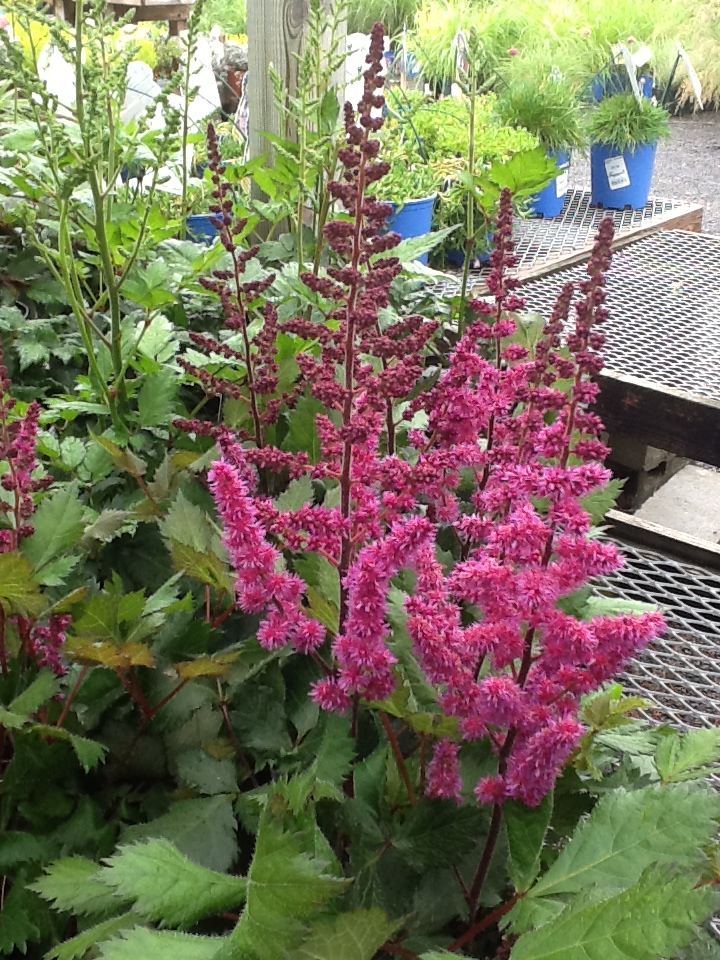 Astilbe (Astilbe) 8” – 4’ tall. Astilbes can handle sun or part shade. They really don’t bloom well in full shade. I prefer the chinensis cultivars that are more drought tolerant than others. To enjoy these colorful white, pink, red, lavender, or purple blooms throughout the summer, make sure to buy Early (mid-June through early July), Mid (July) and Late blooming (mid-July through mid-August) varieties. Astilbes are heavy feeders. To encourage impressive plumes, work in some slow-release fertilizer such as Plant-Tone (organic) or Osmocote (14-14-14) into the soil once a year in early May. Zones 3 – 9
Astilbe (Astilbe) 8” – 4’ tall. Astilbes can handle sun or part shade. They really don’t bloom well in full shade. I prefer the chinensis cultivars that are more drought tolerant than others. To enjoy these colorful white, pink, red, lavender, or purple blooms throughout the summer, make sure to buy Early (mid-June through early July), Mid (July) and Late blooming (mid-July through mid-August) varieties. Astilbes are heavy feeders. To encourage impressive plumes, work in some slow-release fertilizer such as Plant-Tone (organic) or Osmocote (14-14-14) into the soil once a year in early May. Zones 3 – 9
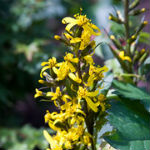 Ligularia (Ligularia) 20” – 4’ tall. What a funky group of plants. They all have intriguing leaves, both in shape and color. The flowers are ‘crunchy’ too. The most common, ‘The Rocket’, has tall yellow spikes in July reaching 4’ – 5’. ‘Little Rocket’ takes it down a notch at 3’ tall. ‘Othello’ and ‘Desdemona’ have chocolate scalloped leaves. ‘Britt-Marie Crawford’ goes the extra mile with dark chocolate-purple foliage and purple undersides.‘Othello’, ‘Desdemona’ and ‘Britt-Marie Crawford’ all have orangey-yellow, daisy-like flowers in August. Ligularias want a moisture-rich site. Along a water’s edge is super. If you don’t have a wet area, create a mini-bog by digging a hole, lining it with some pond liner or heavy plastic, backfill with soil amended with organic matter (compost or aged manure along with some peat moss) and plant. Zones 4 – 9
Ligularia (Ligularia) 20” – 4’ tall. What a funky group of plants. They all have intriguing leaves, both in shape and color. The flowers are ‘crunchy’ too. The most common, ‘The Rocket’, has tall yellow spikes in July reaching 4’ – 5’. ‘Little Rocket’ takes it down a notch at 3’ tall. ‘Othello’ and ‘Desdemona’ have chocolate scalloped leaves. ‘Britt-Marie Crawford’ goes the extra mile with dark chocolate-purple foliage and purple undersides.‘Othello’, ‘Desdemona’ and ‘Britt-Marie Crawford’ all have orangey-yellow, daisy-like flowers in August. Ligularias want a moisture-rich site. Along a water’s edge is super. If you don’t have a wet area, create a mini-bog by digging a hole, lining it with some pond liner or heavy plastic, backfill with soil amended with organic matter (compost or aged manure along with some peat moss) and plant. Zones 4 – 9
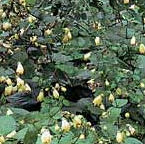 Yellow Waxbells (Kirengeshoma palmata) 3’ tall. Yellow Waxbells have delicate, buttery-yellow flowers that dangle from 3’ arching stems. The foliage is soft green and looks similar to a maple tree’s leaf. Yellow Waxbells form a neat 3’ X 3’ clump. It rarely needs dividing. It makes a handsome pairing with Astilbes, Toad Lilies and Hosta. Zones 4 – 8
Yellow Waxbells (Kirengeshoma palmata) 3’ tall. Yellow Waxbells have delicate, buttery-yellow flowers that dangle from 3’ arching stems. The foliage is soft green and looks similar to a maple tree’s leaf. Yellow Waxbells form a neat 3’ X 3’ clump. It rarely needs dividing. It makes a handsome pairing with Astilbes, Toad Lilies and Hosta. Zones 4 – 8
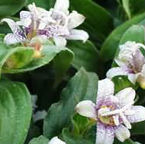 Toad Lily (Tricyrtis) 18” – 36” tall. These unique looking flowers are in the orchid family. Blooms can be solid white, yellow, white with pink or purple markings. Leaves are solid green, green and white, or green and creamy-yellow. All Toad Lilies have arching stems with flowers formed along their stem length. The flowers are petite in size so it’s best to plant a number of Toad Lilies together to create a nice show. Plant them near the front of a bed where these beauties can be appreciated. Zones 4 – 8
Toad Lily (Tricyrtis) 18” – 36” tall. These unique looking flowers are in the orchid family. Blooms can be solid white, yellow, white with pink or purple markings. Leaves are solid green, green and white, or green and creamy-yellow. All Toad Lilies have arching stems with flowers formed along their stem length. The flowers are petite in size so it’s best to plant a number of Toad Lilies together to create a nice show. Plant them near the front of a bed where these beauties can be appreciated. Zones 4 – 8

